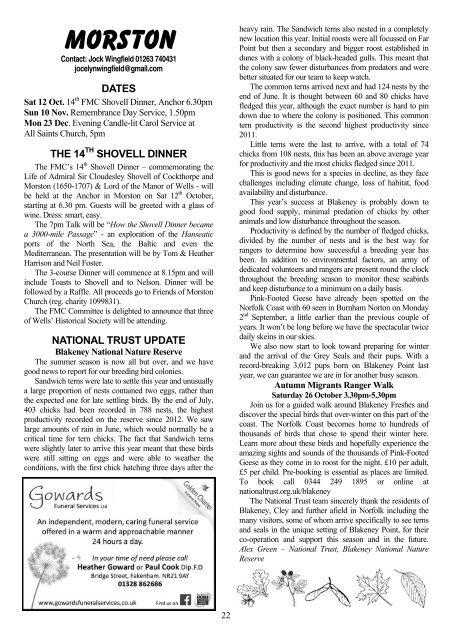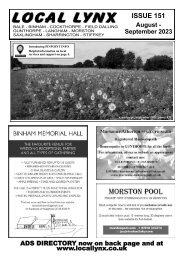Local Lynx Issue 128 - October/November 2019
The community newspaper for 10 North Norfolk villages
The community newspaper for 10 North Norfolk villages
You also want an ePaper? Increase the reach of your titles
YUMPU automatically turns print PDFs into web optimized ePapers that Google loves.
MORSTON<br />
Contact: Jock Wingfield 01263 740431<br />
jocelynwingfield@gmail.com<br />
DATES<br />
Sat 12 Oct. 14 th FMC Shovell Dinner, Anchor 6.30pm<br />
Sun 10 Nov. Remembrance Day Service, 1.50pm<br />
Mon 23 Dec. Evening Candle-lit Carol Service at<br />
All Saints Church, 5pm<br />
THE 14 TH SHOVELL DINNER<br />
The FMC’s 14 th Shovell Dinner – commemorating the<br />
Life of Admiral Sir Cloudesley Shovell of Cockthorpe and<br />
Morston (1650-1707) & Lord of the Manor of Wells - will<br />
be held at the Anchor in Morston on Sat 12 th <strong>October</strong>,<br />
starting at 6.30 pm. Guests will be greeted with a glass of<br />
wine. Dress: smart, easy.<br />
The 7pm Talk will be “How the Shovell Dinner became<br />
a 3000-mile Passage” - an exploration of the Hanseatic<br />
ports of the North Sea, the Baltic and even the<br />
Mediterranean. The presentation will be by Tom & Heather<br />
Harrison and Neil Foster.<br />
The 3-course Dinner will commence at 8.15pm and will<br />
include Toasts to Shovell and to Nelson. Dinner will be<br />
followed by a Raffle. All proceeds go to Friends of Morston<br />
Church (reg. charity 1099831).<br />
The FMC Committee is delighted to announce that three<br />
of Wells’ Historical Society will be attending.<br />
NATIONAL TRUST UPDATE<br />
Blakeney National Nature Reserve<br />
The summer season is now all but over, and we have<br />
good news to report for our breeding bird colonies.<br />
Sandwich terns were late to settle this year and unusually<br />
a large proportion of nests contained two eggs, rather than<br />
the expected one for late settling birds. By the end of July,<br />
403 chicks had been recorded in 788 nests, the highest<br />
productivity recorded on the reserve since 2012. We saw<br />
large amounts of rain in June, which would normally be a<br />
critical time for tern chicks. The fact that Sandwich terns<br />
were slightly later to arrive this year meant that these birds<br />
were still sitting on eggs and were able to weather the<br />
conditions, with the first chick hatching three days after the<br />
heavy rain. The Sandwich terns also nested in a completely<br />
new location this year. Initial roosts were all focussed on Far<br />
Point but then a secondary and bigger roost established in<br />
dunes with a colony of black-headed gulls. This meant that<br />
the colony saw fewer disturbances from predators and were<br />
better situated for our team to keep watch.<br />
The common terns arrived next and had 124 nests by the<br />
end of June. It is thought between 60 and 80 chicks have<br />
fledged this year, although the exact number is hard to pin<br />
down due to where the colony is positioned. This common<br />
tern productivity is the second highest productivity since<br />
2011.<br />
Little terns were the last to arrive, with a total of 74<br />
chicks from 108 nests, this has been an above average year<br />
for productivity and the most chicks fledged since 2011.<br />
This is good news for a species in decline, as they face<br />
challenges including climate change, loss of habitat, food<br />
availability and disturbance.<br />
This year’s success at Blakeney is probably down to<br />
good food supply, minimal predation of chicks by other<br />
animals and low disturbance throughout the season.<br />
Productivity is defined by the number of fledged chicks,<br />
divided by the number of nests and is the best way for<br />
rangers to determine how successful a breeding year has<br />
been. In addition to environmental factors, an army of<br />
dedicated volunteers and rangers are present round the clock<br />
throughout the breeding season to monitor these seabirds<br />
and keep disturbance to a minimum on a daily basis.<br />
Pink-Footed Geese have already been spotted on the<br />
Norfolk Coast with 60 seen in Burnham Norton on Monday<br />
2 nd September, a little earlier than the previous couple of<br />
years. It won’t be long before we have the spectacular twice<br />
daily skeins in our skies.<br />
We also now start to look toward preparing for winter<br />
and the arrival of the Grey Seals and their pups. With a<br />
record-breaking 3,012 pups born on Blakeney Point last<br />
year, we can guarantee we are in for another busy season.<br />
Autumn Migrants Ranger Walk<br />
Saturday 26 <strong>October</strong> 3.30pm-5.30pm<br />
Join us for a guided walk around Blakeney Freshes and<br />
discover the special birds that over-winter on this part of the<br />
coast. The Norfolk Coast becomes home to hundreds of<br />
thousands of birds that chose to spend their winter here.<br />
Learn more about these birds and hopefully experience the<br />
amazing sights and sounds of the thousands of Pink-Footed<br />
Geese as they come in to roost for the night. £10 per adult,<br />
£5 per child. Pre-booking is essential as places are limited.<br />
To book call 0344 249 1895 or online at<br />
nationaltrust.org.uk/blakeney<br />
The National Trust team sincerely thank the residents of<br />
Blakeney, Cley and further afield in Norfolk including the<br />
many visitors, some of whom arrive specifically to see terns<br />
and seals in the unique setting of Blakeney Point, for their<br />
co-operation and support this season and in the future.<br />
Alex Green – National Trust, Blakeney National Nature<br />
Reserve<br />
22

















